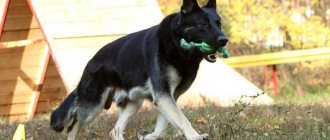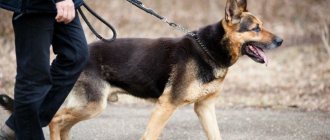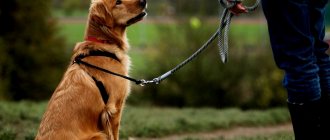Learning commands is necessary for any dog, regardless of breed. Let's look at how to teach a dog and puppy the “Come to me” command. During training, the pet does not feel intense physical or emotional pressure, so it is worth starting at 1.5 months. There are two types - normative and household.
In the first case, the animal, when it hears this phrase, should run up to the owner. Go around it from the right side and behind, sit down on the left. In everyday life, it’s enough for the dog to just come and sit. The dog should not stand and spin, but rather take a sitting position. So he completely turns his attention to the owner.
The “come to me” command: we act correctly
Immediately get ready to train your pet to correctly carry out the command, and not “just to come,” but act consistently and gradually, without unnecessary haste.
The algorithm consists of several elements:
- dog approach;
- landing opposite (IPO requirements) or at the trainer’s left leg (after walking around, according to the OKD course);
- releasing the dog (cancel command).
That is, the dog doesn’t just run up, poke you with his nose and run off in an unknown direction. He approaches, fixes his position near the owner and moves away only after permission. Remember, the dog must be “released from command”!
The command “walk” (play, run) serves as a cancellation. The dog's landing (fixation) begins to be practiced only after a stable approach to the call. Otherwise, the tailed student may develop a negative attitude towards the team: they call you, they force you to sit down, but I won’t go. At first, it will be enough to fix the command by touching the collar.
Choosing a dog treat
Most methods of teaching the “Come to me” command involve rewarding with a treat. Food motivation rightfully occupies a leading place, since dogs at any age respond well to it.
The treat should be desirable and attractive. Common options are:
- Cheese cubes.
- Special industrial delicacies in the form of meat pieces or crackers.
- Pieces of dried meat or offal.
- Flavored dry food granules.
When choosing treats, it is extremely important to consider their calorie content and nutritional value. Many owners train dogs by rewarding them with cookies, sugar or other sweets. Undoubtedly, a dog responds better to sweet treats, but for its health, such motivation plays a negative role.
How to teach your dog the “come” command: a complete guide
Apartment activities.
- Learning the approach begins as soon as the baby gets used to his nickname.
- In the first stages, you can give a command before feeding. Attract the puppy's attention, give a command, praise and place the bowl.
- Continue learning "in between" during games. If you see that the puppy is heading towards you, give a command and joyfully praise it.
Walking exercises
- First, choose a quiet place to work with a minimum amount of irritants.
- As you learn, the task becomes more difficult. But the main thing is to take your time!
- To control your dog, it is better to use a long leash or exercise in a fenced area.
- A leash is needed for the safety of the animal. It is not advisable to use jerks; this is a last resort method. The dog should come to you on its own. Cunning people quickly understand when you can physically influence them and when you can’t.
- Let the dog go for a walk. Dog handlers call this “unloading.”
- Call the dog. You can clap your hands, make an unusual sound (“meow” is quite suitable). Get the dog to switch from the outside world to you.
- Attention, very important point! Don’t rush to shout “come to me.” Now your goal is to provoke the dog to approach. To do this, sometimes it’s enough just to turn sideways, take a step back, squat down, show a treat, pretend to run away. Try different options.
- The command “come” is pronounced only after the dog purposefully runs towards you. Why? The dog may be distracted, approach slowly and sadly, or even forget why it was called. And in this case, it will be remembered in the long-eared head that there is no need to rush to execute the command.
- When the pet confidently heads towards you, give the command in the most friendly tone possible and reward the student for approaching so that all the surrounding dogs will have tears of envy.
- Release the dog on command (“walk”).
When your four-legged friend has formed a clear picture that the execution of the “come to me” command is always accompanied by a celebration (tasty things, games, praise), the first stage can be considered completed. Now you can begin to restrain the dog “according to science”: gently, without pressing, achieving the correct position.
Features of training with an adult dog and a puppy
An adult, untrained pet is a problem, but not as difficult as it seems. The specifics of training with an adult dog and a puppy are distorted by public opinion. Let's debunk two very popular myths:
- It is believed that puppies learn better than adult dogs - in terms of training, adult dogs are superior to puppies in the speed of mastering skills. However, it is more difficult to work with older dogs when it comes to behavior correction and established habits.
- If a dog has not mastered skills before the age of one, it is useless to train it - a dog can be trained at any age, moreover, some breeds and outbred animals need to acquire new skills for life.
There are also differences in approaches to training an adult dog and a puppy:
- Puppies are more motivated and can be trained using any stimulus.
- Puppies almost always react to a food stimulus.
- It is more difficult to find an approach to an adult dog, especially if it lived in poor conditions.
- It is more difficult to establish a trusting relationship with an adult dog if it has been hurt by people.
Tip: When training an adult dog, many experts recommend trying the “puppy methods” first.
If insurmountable difficulties arise during the learning process, the owner will have to invent more cunning ways of motivation or seek help from professionals.
Mistakes when teaching the “come to me” command or what not to do
Be patient, have a good mood and remember the five main “don’ts”.
- You cannot punish or scold the dog after the command “come to me” has sounded! Even if on the way to you she ate a dead cat or drove a cyclist into the lake. A dog's short-term memory will associate punishment with the fact that the command was followed.
- You can’t end your walk with the command “come to me”! Approaching the owner doesn't have to mean the end of the fun. Calculate the time correctly, call the animal, play and only then put it on a leash and go home. It is ideal if after the game you walk a little more with your pet on a leash.
- You cannot say “to me” more than once! “Come to me” is too important a command and requires an instant reaction from the dog. Therefore, never command “to me” if there is even the slightest doubt that the dog will come. Use alternative options: “come here”, “on”, “here’s a parasite.” “Come to me” is non-negotiable!
- You can't run after the dog yourself! Doesn't fit with "come here"? Run away yourself. Seriously run away, let him be afraid of losing you. But when the dog runs after you, give the command.
- You cannot command “come to me” in an angry, threatening voice; you must use only joyful intonations. And pay attention to the position in which you give the command. Body language is very important for four-legged friends. Many dog owners, without realizing it, take a threatening pose when calling their animal: they look straight, hold their body straight, or spread their arms, leaning slightly forward. This will not add enthusiasm to the student. Make room for the dog to approach: bend your knees, turn around a little (gestures of reconciliation). You can jump up and pat yourself on the knees. Don't be shy, show how happy you will be when your favorite dog comes over.
Training command “Walk!”
Why does a dog need the command “Walk!”? The ability to walk on command is necessary when the dog needs to rest after training or when you need to finish executing a previously given command. Remember: the dog can only stop following a command with permission! This technique must be practiced in parallel with mastering the dog’s approach to the command “Come to me!” and its movement with the owner on the command “Near!”.
When teaching a dog this command, as a rule, no special difficulties arise, since dogs love to walk. You use the command "Walk!" and a gesture - energetically throwing out the right (left) hand in the direction of the desired direction of the dog's movement.
Practicing the skill. For your first lessons, choose a calm, preferably secluded place without strong distracting stimuli. The dog should be next to you on a long leash. Lower the leash to the ground, give the command “Walk!” in an approving tone, show her the gesture (holding your hand in an extended position for a few seconds, then lowering it) and send her for a walk. If the dog moves away hesitantly, run energetically for a few meters, repeating the command periodically. After a short run, give your dog the opportunity to take a walk. If the dog still shows caution and uncertainty, play with it.
After a 5-10 minute walk, call the dog with the command “Come!” For a timely and correct approach, reward him (with a treat, stroking, exclamation “Good!”), hold him near you for a while and let him go for a walk again. During the initial training period, be sure to walk the dog on a long leash: in emergency situations, it will always be possible to limit the dog’s mobility. Do not give the command “Walk!” too loud, do not allow sharp and strong jerks with the leash, constantly monitor the dog.
After the dog has learned the initial skill of executing the “Walk!” command, begin walking it without a leash in quiet and then in noisier places, paying attention to the dog’s behavior.
Step by step training
You can start teaching your puppy this command when he gets used to it and responds to his name. At first, you can serve it before feeding:
- you should attract the baby's attention;
- say “come to me!”;
- praise;
- place a bowl in front of him.
You can train while playing with your dog. When the baby starts walking towards the owner, he must say a command and praise him. You can do this at home, but don’t forget about street training. The place should be quiet and familiar to the dog so that it does not worry or is distracted.
If the area is not fenced, then you can use an extended leash; this will not only allow you to control the puppy, but also protect it. You can act according to the following algorithm:
- the pet should be allowed to go for a walk;
- then it is recommended to attract the dog’s attention (you can try various methods: calling, clapping, unusual sound, running away, etc.); the command “come to me!” pronounced only when the dog begins to run towards the owner; a friendly tone is required;
- encouragement should be generous - affection, treats, games; the dog must be happy;
- you should cancel the command by saying “go, walk, etc.”
When the dog understands that the correct execution of the “come to me” command is a real holiday and will carry it out unquestioningly, you can begin the fixation stage. The dog can only learn the command correctly if the owner behaves properly. You can’t run after a disobedient dog, it’s useless to shout a command a thousand times, end a walk with it, or stop the game.
The team should be associated exclusively with positive moments, before which all other pleasures pale. This is the only way to teach a dog to instantly stop everything he’s doing and joyfully run to his owner, without reacting to surrounding stimuli and so on. An obedient dog is a joy for the owner and the envy of other, less fortunate dog owners.
You can find other commands in the “” section.
Command “Come to me!” is one of the main ones that allows you to control the animal, at the same time, without limiting its freedom. The command is applicable in everyday life, but is also included in the standards.
The exercise begins as soon as the pet has learned to respond to its name, at approximately 1.5 months of age. Classes are held indoors in a calm environment. Prepare treats and the puppy’s favorite toys in advance, which will serve as motivation. A long leash is put on the pet. The dog must be hungry.
Choosing a place to train your dog
The success of training is influenced by the choice of place for training the dog. There are two options: in the apartment or on a walk. If everything is clear with the first one, then before going out you should prepare. Tips - the place should be well known to the pet; At first, it is better to be located in a fenced and quiet area.
Common places are special areas for dogs. As you learn, you can move to open spaces.
Executing the command correctly
There are 2 variations of the pet’s execution of the “come to me” command. Namely:
- For home use. Correct execution means that the dog must come when called, sit down and concentrate on the owner.
- According to OKD standards. This option is a little more complicated - before boarding, the dog must go around the owner from behind and sit on the left side.
Depending on which specific execution option is needed, a specific command execution option is used.
Training for daily use
It’s worth noting right away that it’s better to start learning the command at home. Gradually, you can conduct training outside, but in a quiet place.
Only when your pet has learned his lessons well can you try calling him in busy places and in the presence of distractions.
Attention! The rule regarding starting classes at home and gradually repeating them during a walk concerns the practice of all commands.
To teach your pet to come when called and sit down, you will need an assistant. Together with it you will need to do the following:
- The assistant must take the dog on a leash, and if it is a small puppy, in his arms.
- The owner must remain in place with the prepared treat.
- The assistant should slowly back away and take the dog to a distance of 2-3 meters.
- After the owner commands “come to me,” the dog is let off the leash and the puppy from the hands.
- When the dog runs up, you should definitely praise him and give him a treat.
This exercise must be repeated 5-6 times. You should not do more repetitions - the dog will lose interest and there will be no benefit from such a long training.
To begin with, when training in an apartment, you can take your pet a short distance, gradually increasing it. At the final stage, you can take the puppy to another room - this will allow you to practice the option of executing a command by voice, that is, without the owner’s visibility.
Training according to the OKD standard
You can practice a command using a complicated version in the same way as for daily use.
But in this case, the difference lies in the completion of the performance - the delicacy is not given immediately. After the dog has approached, the owner, using a treat clenched in his fist, “leads” the pet behind his back and stops his hand on the left side.
Then, at the sign of a raised hand or the command “sit,” the pet must sit down and only then receive a treat.
According to the OKD standard, the dog must, after approaching, sit on the left hand of the owner
Breed characteristics of training
There is an unspoken division between dogs that are easy and difficult to train. This division is not entirely correct, since absolutely all four-legged animals are capable of learning, subject to the correct approach and motivation.
Difficulties may arise during training due to the following factors:
- Active temperament - if the dog is in an excited state, it cannot concentrate. Choleric dogs are recommended to be actively walked before each lesson.
- High degree of independence - usually, independent dogs are phlegmatic and think for a long time before executing a command. A striking example is Caucasian Shepherd Dogs, Central Asian Shepherd Dogs, Great Danes, Mastiffs, etc. With representatives of independent breeds, you need to show more patience during training, in addition, the set of commands that the dog learns is greatly reduced. The dog is not taught commands that are not required to ensure safety.
If you are planning to get your first dog, it is better to choose a breed that is designed for quick training. There are a lot of breeds that are human-oriented, the most popular of them are: German Shepherd, Labrador Retriever, Golden Retriever.
Note! It is important to understand that representatives of the breed, which are easy to train, will not make progress in training if there is insufficient walking and physical activity, poor quality care and feeding.
What to do if the dog does not obey and runs away
Indeed, how can you teach a dog to call if it doesn’t listen and runs away as soon as the leash is unfastened?
Factors that can provoke escapes:
- Breed – active dog breeds are prone to running away. The record holders in this sad ranking are huskies, malamutes, dachshunds, cocker spaniels, shorthaired pointers, drathaars, beagles and other representatives of northern and hunting breeds.
- Discomfort – the dog may not obey and run away if it is cold or hot. Short-haired dogs need to be dressed for winter walks. In hot weather, training and walking should be moved to early morning and late evening.
- Sexual instinct - during the heat season, even the most disciplined dogs, especially males, can become disobedient.
- Phobias - a dog may not obey and run away if it is afraid of something. The feeling of fear is much stronger than the authority of the owner. The dog may be afraid of loud noises, vehicles, other animals or people.
Until you understand the reasons for the escape, your pet must be walked on a leash and actively trained. With a systematic approach to training, the dog will obey, despite the strongest stimuli.
Method number 2 – Training in pairs
A method that is suitable for both puppies and adult dogs. For training you will need a partner with a trained pet.
The essence of training is that dogs are prone to imitation. When you go for a walk, stand next to your partner and let the dogs go for a walk. The first 2-3 times, the partner gives a clear command “Come to me” and generously praises his pet for obedience.
When your pet becomes interested in the process, after giving the command to your partner, pat your thigh with your palm so that your dog can see it. If your pet approaches, praise him generously. Gradually, monitoring the dog’s reaction, move on to synchronized commands.
Note! It is extremely important not to rush into giving a voice command until your pet is ready for it.
Method #1 – Home Training for Puppies
Until the puppy has received basic vaccinations and has not adapted to walking outside, it can be taught the “Come to me” command at home.
It is important to follow a number of rules:
- Do not skimp on motivation, treats and praise - “Come to me”, this is the most important command from the entire complex of general training.
- Give the command only once - if the puppy gets used to you giving the command 3-4 times, in the future you will not get obedience from him.
- Give your puppy time to think – some breeds and phlegmatic dogs have a tendency to think for 10-30 seconds before following a command.
To conduct initial training, call the puppy within the same room. To motivate your pet, clap your hands, sit down, and beckon your baby with your hands. Praise your puppy generously for his obedience and willingness to learn.
Important! Do not combine teaching the “Come to me” command with eating! If necessary, teach your pet a separate “Eat” command.
Method - treat
A common method in training is treats. The method is considered simple but effective. Suitable for dogs of all ages. Before the start of classes, the owner will need to stock up on a large number of treats. Instructions:
- Stand a short distance from your pet.
- Squat down, spread your arms to the sides.
- Call your pet by name, adding the phrase “Come to me.”
- Cheer when your pet goes in the right direction.
- Provide a treat at the end.
You should exercise every day. Puppies get tired quickly, so 5-10 minutes of training per day will be enough. Gradually, you need to increase the distance and duration of training. It's better to start at home.











